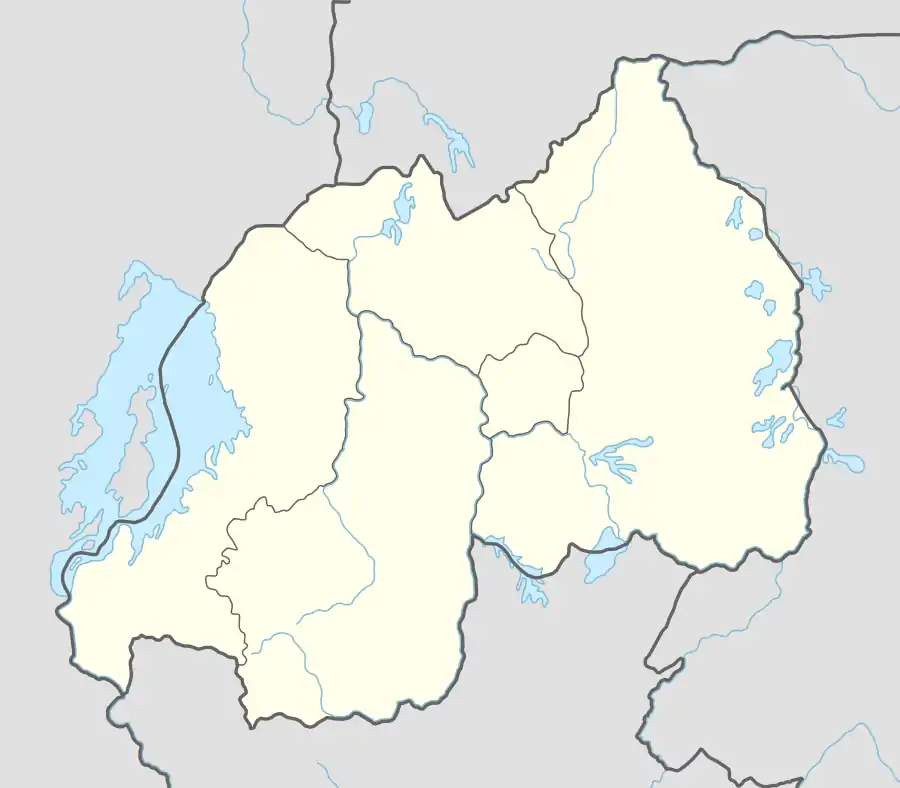Volcanoes National Park
Volcanoes National Park is a national park in northwestern Rwanda. It covers 160 km2 (62 sq mi) of rainforest and encompasses five of the eight volcanoes in the Virunga Mountains, namely Karisimbi, Bisoke, Muhabura, Gahinga and Sabyinyo. It borders Virunga National Park in the Democratic Republic of Congo and Mgahinga Gorilla National Park in Uganda. It is home to the mountain gorilla and the golden monkey, and was the base for the primatologist Dian Fossey.
| Volcanoes National Park | |
|---|---|
| French: Parc National des Volcans Kinyarwanda: Pariki y’Igihugu y’Ibirunga | |
IUCN category II (national park) | |
 Mount Bisoke in Volcanoes National Park | |
 Location of Volcanoes National Park | |
| Location | Rwanda |
| Coordinates | 01°28′03″S 29°29′33″E |
| Area | 160 km2 (62 sq mi) |

History

The park was first gazetted in 1925, as a small area bounded by Karisimbi, Bisoke and Mikeno, intended to protect the gorillas from poachers. It was the very first National Park to be created in Africa. Subsequently, in 1929, the borders of the park were extended further into Rwanda and into the Belgian Congo, to form the Albert National Park, a huge area of 8090 km2, run by the Belgian colonial authorities who were in charge of both colonies.[1] In 1958, 700 hectares of the park were cleared for a human settlement.[2]
Between 1969 and 1973, 1,050 hectares of the park were cleared to grow pyrethrum.[2]
The park later became the base for the American naturalist Dian Fossey to carry out her research into the gorillas. She arrived in 1967 and set up the Karisoke Research Centre between Karisimbi and Visoke. From then on she spent most of her time in the park, and is widely credited with saving the gorillas from extinction by bringing their plight to the attention of the international community. She was murdered by unknown assailants at her home in 1985, a crime often attributed to the poachers she had spent her life fighting against.[3] Fossey's life later was portrayed on the big screen in the film Gorillas in the Mist, named after her autobiography. She is buried in the park in a grave close to the research center, and amongst the gorillas which became her life.
The Volcanoes National Park became a battlefield during the Rwandan Civil War, with the park headquarters being attacked in 1992. The research centre was abandoned, and all tourist activities (including visiting the gorillas) were stopped. They did not resume again until 1999 when the area was deemed to be safe and under control. There have been occasional infiltrations by Rwandan rebels from the Democratic Forces for the Liberation of Rwanda in subsequent years, but these are always stopped quickly by the Rwandan army and there is thought to be no threat to tourism in the park.
Flora and fauna
Flora
Vegetation varies considerably due to the large altitudinal range within the park. There is some lower montane forest (now mainly lost to agriculture). Between 2400 and 2500 m, there is Neoboutonia forest. From 2500 to 3200 m Arundinaria alpina (bamboo) forest occurs, covering about 30% of the park area. From 2600 to 3600 m, mainly on the more humid slopes in the south and west, is Hagenia-Hypericum forest, which covers about 30% of the park. This is one of the largest forests of Hagenia abyssinica. The vegetation from 3500 to 4200 m is characterised by Lobelia wollastonii, L. lanurensis, and Senecio erici-rosenii and covers about 25% of the park. From 4300 to 4500 m grassland occurs. Secondary thicket, meadows, marshes, swamps and small lakes also occur, but their total area is relatively small.
Fauna
The park is best known for the mountain gorilla (Gorilla beringei beringei). Other mammals include: golden monkey (Cercopithecus mitis kandti), black-fronted duiker (Cephalophus niger), buffalo (Syncerus caffer), spotted hyena (Crocuta crocuta) and bushbuck (Tragelaphus scriptus). The bushbuck population is estimated to be between 1760–7040 animals. There are also reported to be some elephants in the park, though these are now very rare. There are 178 recorded bird species, with at least 13 species and 16 subspecies endemic to the Virunga and Rwenzori Mountains.[4]
See also
References
- Philip Briggs & Janice Booth (2001) Rwanda: The Bradt Travel Guide p171. Bradt Travel Guides Ltd. and The Globe Pequot Press Inc. ISBN 1-84162-034-3
- ORTPN (2004). Plan d’aménagement de Gestion du Parc National des Volcans. Draft 2. Office of Tourism and National Parks (ORTPN), Kigali.
- Philip Briggs & Janice Booth (2001) Rwanda: The Bradt Travel Guide p172. Bradt Travel Guides Ltd. and The Globe Pequot Press Inc. ISBN 1-84162-034-3
- Volcanoes National Park Page United Nations Environment Programme World Conservation Monitoring Centre
External links
| Wikimedia Commons has media related to Volcanoes National Park. |
- "Volcanoes National Park".
- Kwita Izina : An annual celebration of conservation, where baby mountain gorillas are named every year. The ceremony raises awareness of the importance of conservation and is drawn from Rwandan cultural tradition where members of a community would gather to celebrate the birth of a new baby and give the newborn a name
- BirdLife International. "Important Bird Areas factsheet: Volcans National Park".
- Volcanoes National Park at UN Environment Programme World Conservation Monitoring Centre